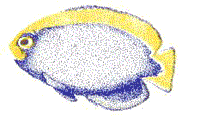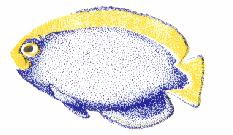|
THE MOLLUSCS, PART 3: THE BIVALVES
By Jim Wolf C.S.U.N. Marine Biologist
ODYSSEA ( MASLA ) Volume 3, Issue 2
The bivalves are the second largest group of molluscs with about 8,000
described species. These organisms, as the name implies, have two shells.
Most bivalves have two equal sized shells however, some (ex. oysters and
scallops), have one shell that is cemented to the substrate, and this gives
them an irregular appearance. The foot on these animals is adapted for
digging ( as in burrowing clams) or to attach byssal threads (as in mussels).
This thread is secreted by the animals, has the tensile strength of steel,
and helps to anchor the mussel firmly to the substrate. The radula is absent
as most bivalves feed by filtering the water, so their food does not require
much grinding up. The head is greatly reduced and they have the unique
gastronominal phenomena of having their intestine run through their heart!!
Most have primitive "eye spots" that can detect light and dark, and some
species when hassled can move by squirting water out of their body cavity.
When you introduce your new bivalve to the aquarium, make sure that you
place it properly, as they do not like to be moved.
Here are a few more hints on care and feeding of certain bivalves.
Bivalves can be divided into two groups. Those that basically feed themselves,
and those that require frequent feedings of liquid invertebrate foods and
live phytoplankton (floating microscopic plants). Tridacna clams (Giant
Clams) actually feed themselves by harvesting algae that is living in their
tissues. They require a clean aquarium with powerful lighting, stable temperature,
and an occasional supplement of trace elements to thrive. Tridacna clams
should be placed in an area of high light and low flow. Place them into
the aquarium so that the open part of the shell is oriented up. In a short
time the mantle will expand, and insure that there is a good 1 to 2 inches
on either side of the animal to permit full mantle expansion.
The remaining bivalves rely solely on filtering food from the water
for their nutrition. These bivalves include: Flame Scallops, Spiny and
Rock Oysters, and different types of mussels. Place the specimen in an
area of low flow and diminished lighting. Most of the specimens will stay
where you put them, however flame scallops and mussels can relocate themselves
if they choose. The best food for these specimens is a steady diet of phytoplankton.
About two to three times a week, shut off all of the mechanical filters
(except for aeration) and add the phytoplankton then restart the mechanical
filters after a few hours You can deliver it close to the bivalve using
a modified turkey baster. About 1 cup of phytoplankton per every 20 gallons
of water 2-3 times a week is a good feeding schedule. In a reef aquarium
you will often find many species of bivalves encrusting the live rock.
If you have many encrusting bivalves on your live rock (as well as other
filter feeding encrusting critters), a diet of phytoplankton (as described
above) is an excellent way to insure the survival of many of the tank's
live rock inhabitants.
|











